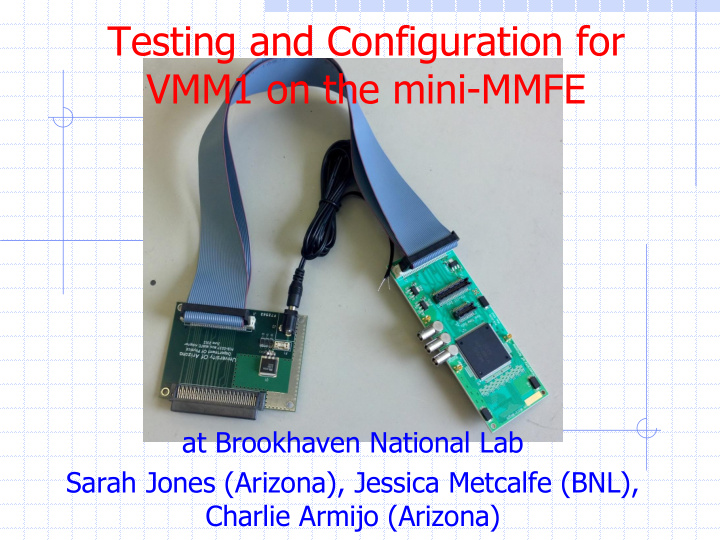



Testing and Configuration for VMM1 on the mini-MMFE at Brookhaven National Lab Sarah Jones (Arizona), Jessica Metcalfe (BNL), Charlie Armijo (Arizona)
Testing the mini-MMFE USB connection 2
Timing Example for New Setup At peak, ramp begins for Timing Measurements, CHN 5 timing between peak and 965.000 readout signals. Slope of 960.000 ramp gives conversion from 955.000 voltage to time. Ideally, TDO time [ns] 950.000 slope = constant 945.000 940.000 935.000 125 175 225 275 325 TAC Slope measurement Ouput Pulse Amplitude (PDO-BL) [mV] y = 0.634x + 189.1 900 800 700 600 TDO (mV) 500 400 300 200 100 0 0 200 400 600 800 1000 1200 3 peak to enable time (ns)
Noise Measurement Example Noise measurements with RMS vs peaking time for various Gains (0.5, 1, 3, 9 mV/fC) CHN 64 noise: Gain Noise Measurement, CHN 64 unmasked nearby channels 0.600 0.500 0.400 RMS (mV) Gain 0.5 mV/fC 0.300 Gain 1 mV/fC Gain 3 mV/fC Gain 9 mV/fC 0.200 0.100 0.000 0 50 100 150 200 250 peaking time (ns) 4
Plans Testing of the mini-MMFE was successful with only minor issues Next steps are to: Assemble remaining 10 mini-MMFE (left- handed) this week and begin testing at BNL late next week Fabricate V2 adapter card (with LVDS to RSDS conversions) this week May not be needed but will have it anyway Begin layout of right-handed mini-MMFE Few day job 5
Issues with Current Boards Digital ground and digital signal switched ena and wen signal pins switched a0-a5 address pins switched in order TDO and PDO signal connectors switched Ribbon cables (for 60 to 60 pin) are difficult to construct Silkscreen issues 6
VMM1 Readout Plan 7
New “C - Card” Existing BNL DAQ board with ADCs and Cyclone IV for readout, configuration AVNET LX9 with Spartan 6 FPGA for ethernet connection to switch 8
DAQ Status and Plans UDP datagram sent between client and server at Arizona Can be used for testing with Mamma DAQ UDP datagram sent from LX9 at Harvard Will be tested at Arizona this week Communication between Jack’s BNL DAQ board and LX9 progressing well Integration at BNL 7/2 – 7/11 including George Iakovidis et al. Need meeting with Marcin on Mamma DAQ end 9
UDP UDP Server Client UDP Datagram ACK UDP client and server are running on a LAN. We have sent a big-endian datagram via the UDP client on the laptop, which is a sample event in the current format. We have received the datagram on a desktop computer and unpacked three 32-bit words of the event to correctly obtain each address, timing, and amplitude included. The server sends an ack, which in this case completes the transaction. The Spartan6 LX9 will replace the laptop as soon as we get the compiled image.
Recommend
More recommend